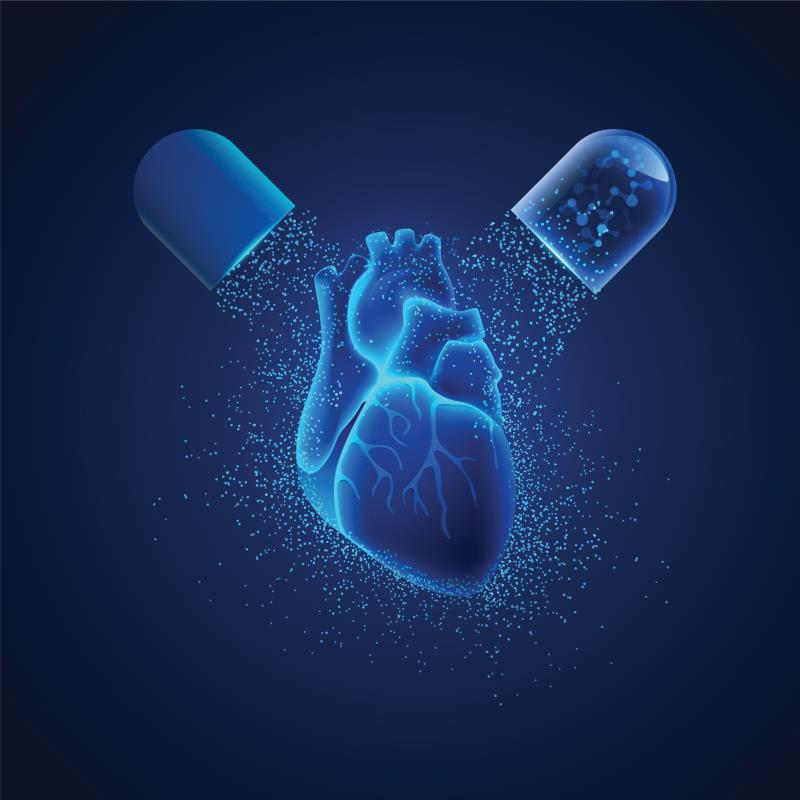Optimal ACEi/ARB + beta-blocker therapy key to improved outcomes in HFrEF





Patients with heart failure with reduced ejection fraction (HFrEF) who achieve 100 percent guideline-recommended target dose (GRTD) for both angiotensin-converting enzyme (ACE) inhibitors/angiotensin receptor blockers (ARBs) and β-blockers have a reduced risk of all-cause mortality and heart failure hospitalization (HHF), a recent study showed.
“Not surprisingly, the best outcomes were observed in those who achieved 100 percent GRTD of combined therapy. However, in the vast majority of patients not reaching 100 percent GRTD, taking any dose combination was better than none, and achieving lower doses of both drug classes was associated with better outcomes than reaching the highest dose of only one class,” noted the authors.
The study population included 6,787 adults with HFrEF (left ventricular ejection fraction [LVEF] ≤40 percent; mean age 62.6 years, 77.7 percent male, mean LVEF 27.7 percent) enrolled in the BIOSTAT-CHF and ASIAN-HF* registries, comprising European and Asian populations, respectively (n=2,100 and 4,687, respectively). Target doses of medications were based on European Society of Cardiology (ESC) guidelines.
Only 14 percent of patients achieved GRTD ≥50 percent for both ACE inhibitors/ARBs and β-blockers (successful up-titration), with 3 percent achieving 100 percent GRTD. [Eur J Heart Fail 2020;doi:10.1002/ejhf.1869]
When doses of both ACE inhibitors/ARBs and β-blockers were up to 1–49 percent GRTD, the risk of the composite outcome of all-cause mortality or HHF was lower than that with no treatment (hazard ratio [HR], 0.71, 95 percent confidence interval [CI], 0.61–0.84; p<0.001). This was further reduced when the dose of either drug was 50–99 percent GRTD and the other 1–49 percent GRTD (HR, 0.50 and 0.61 for 1–49 percent GRTD for β-blockers and ACE inhibitors/ARBs, respectively; p<0.001 for both). The reduced risk was also greater than that achieved with 100 percent GRTD for β-blockers alone (HR, 0.68; p=0.02) or ACE inhibitors/ARBs alone (HR, 0.71; p=0.03).
Patients who achieved 100 percent GRTD for both ACE inhibitors/ARBs and β-blockers experienced the greatest risk reduction (HR, 0.32, 95 percent CI, 0.26–0.39; p<0.001).
All-cause mortality risk was lowest among patients with 100 percent GRTD for both ACE inhibitors/ARBs and β-blockers (HR, 0.19; p<0.001) compared with untreated patients, followed by 50–99 percent GRTD for ACE inhibitors/ARBs and 100 percent for β-blockers (HR, 0.27; p<0.001). Achieving 100 percent GRTD for ACE inhibitors/ARBs alone did not significantly affect mortality risk (HR, 0.75; p=0.11), while increasing doses of β-blockers alone led to decreasing mortality risk (HR, 0.75; p=0.006, HR, 0.65; p=0.004, and HR, 0.40; p<0.001 for 1–49, 50–99, and 100 percent GRTD, respectively). Achieving 100 percent GRTD of both drugs did not affect HHF risk (HR, 0.85; p=0.17).
“[A]lthough the best outcomes were observed in patients attaining 100 percent GRTD for both ACE inhibitors/ARBs and β-blockers, such combined maximal up-titration was rarely achieved [in both Europe and Asia],” noted the authors. There are a multitude of reasons for this including cost, drug intolerance or adverse effects, polypharmacy, and poor compliance.
“Our results [also] suggest that up-titration to even sub-target doses of both ACE inhibitors/ARBs and β-blockers was associated with better outcomes than full up-titration to 100 percent target doses of a single drug class (with either none or very low doses of the other drug class),” they continued.
“[The findings imply] that when faced with the clinical conundrum of up-titrating both drugs vs up-titrating only one of the drugs to maximal target doses, the former may be a preferable approach,” they said.